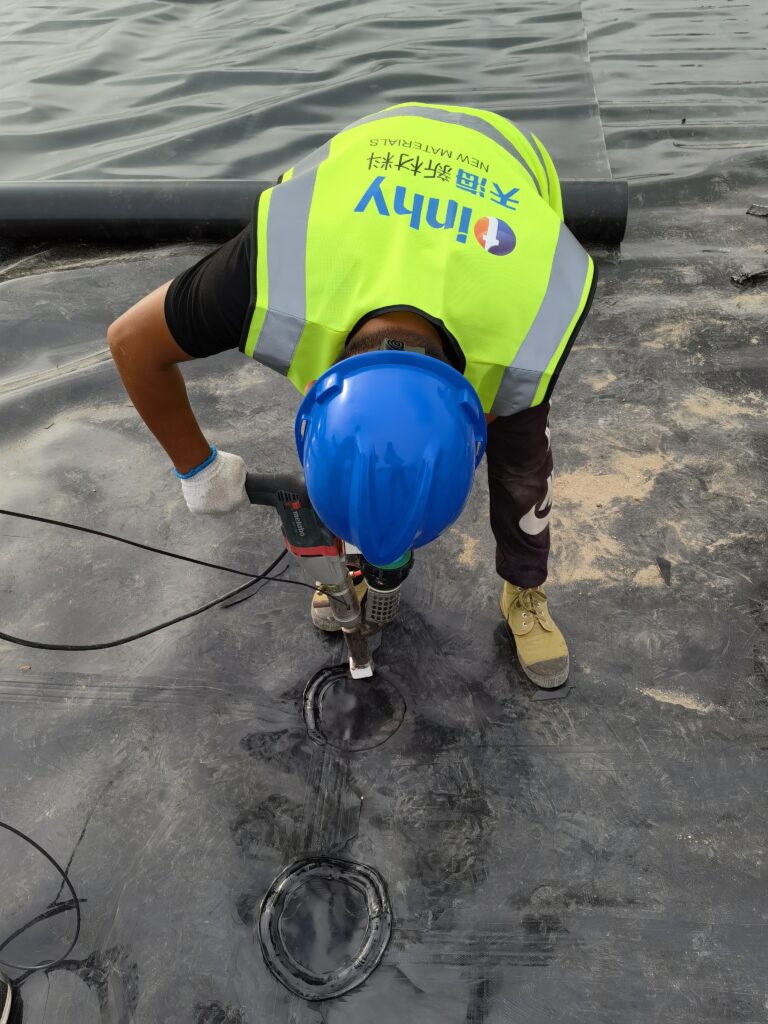Geomembrane production process steps
Raw material preparation: Select the appropriate geomembrane material, such as high-density polyethylene (HDPE) or linear low-density polyethylene (LLDPE), and inspect and prepare it.
Material melting: Raw materials are melted and heated to convert them into melts under specific temperature and pressure conditions.
Calendering and extrusion: The molten material is extruded through a special extruder to form a film-like geomembrane. The extruder usually consists of a screw and a heating barrel, which allows the melt to be extruded into a film through a die or extrusion port, and is continuously extended, cooled, and fixed in width to form the basic shape of the geomembrane.
Film making process control: In the manufacturing process of geomembrane, key parameters such as extrusion speed, cooling rate, and tension strength need to be controlled to ensure that the thickness uniformity and physical properties of the geomembrane meet the requirements.
Product cutting and rolling: After cooling and width determination, the geomembrane will be cut and rolled by cutting equipment to form a geomembrane roll of standard length for easy storage and use.
Quality inspection: Conduct quality inspection on the thickness, size, physical properties, etc. of the geomembrane to ensure that it meets relevant standards and specifications.
Packaging and delivery: Geomembranes that pass quality inspection will be packaged, usually in rolls or stacks, then marked, recorded with corresponding information, and finally arranged to be shipped to customers.

Geomembrane quality testing standards
Thickness: To measure the thickness of the geomembrane, a special thickness measuring instrument is usually used for detection. Thickness is one of the important indicators of geomembrane quality, and the commonly used unit is millimeters (mm).
Strength and Tensile Properties: The mechanical strength and ductility of geomembranes are evaluated through tensile testing. Common test indicators include Tensile Strength, Elongation at Break and Tear Strength, which can be evaluated through standardized tensile testing methods.
Chemical resistance: Evaluate whether the chemical resistance of the geomembrane meets the requirements, including acid and alkali resistance, solvent resistance, corrosion resistance, etc. Common chemical performance test indicators include chemical stability, solubility, deformation and weight loss in acid and alkali solutions, etc.
Anti-permeability performance: Test the permeability performance of the geomembrane, including water permeability and gas permeability. Commonly used test methods include water permeability test, gas permeability measurement, diffusion coefficient, etc.
Dimensional stability: Test the dimensional stability of the geomembrane under different temperature and humidity conditions to evaluate its performance in different environments. Commonly used test indicators include dimensional stability, linear thermal shrinkage, thermal expansion coefficient, etc.
Environmental impact: Evaluate the impact of geomembrane on the environment, including ecotoxicity, degradability, etc. Commonly used test items include biological degradability, such as biodegradability, biological toxicity testing, etc.

